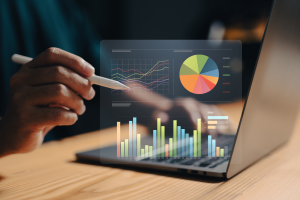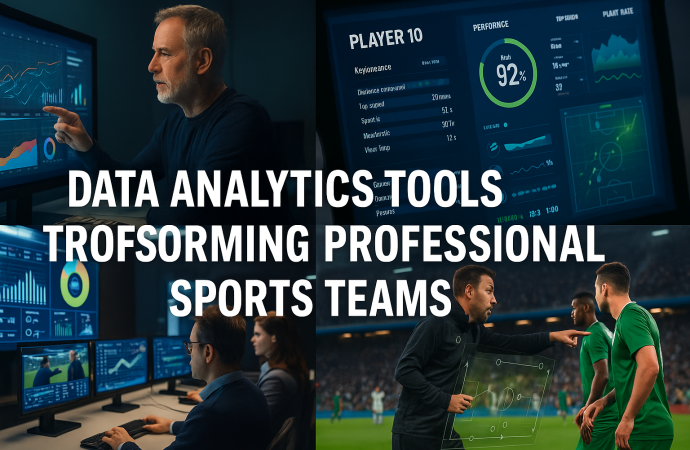Introduction Data analytics is reshaping professional sports. In 2025, teams use powerful tools to track every movement, predict injuries, and craft winning strategies. Gone are the days of coaches relying only on gut feeling. Today’s decision makers draw on real‐time metrics from wearable sensors, video analysis platforms, and AI models. These technologies boost player performance,
Introduction
Data analytics is reshaping professional sports. In 2025, teams use powerful tools to track every movement, predict injuries, and craft winning strategies. Gone are the days of coaches relying only on gut feeling. Today’s decision makers draw on real‐time metrics from wearable sensors, video analysis platforms, and AI models. These technologies boost player performance, lower injury risk, and even engage fans in new ways. Whether you follow soccer, basketball, football, or baseball, data drives every choice on and off the field. This article explores the top analytics tools transforming pro sports teams. You’ll learn how each tool works, its benefits, and tips for successful implementation. By the end, you’ll see why data is now as vital as talent and teamwork.
What Is Sports Data Analytics?
Sports data analytics means collecting and studying data to make informed decisions. Teams gather numbers on speed, heart rate, shot accuracy, and more. Analysts use software to turn raw data into easy‐to‐understand reports and charts. Leaders then plan training, tactics, and recovery based on these insights.
Defining the Field
Data analytics in sports covers performance, health, tactics, and business. It uses statistics, machine learning, and visualization. Teams hire data scientists and performance analysts to manage this work. The goal is to gain a competitive edge through objective evidence.
Key Data Sources
Wearable trackers record player movement and biometrics. Cameras and computer vision track ball and player positions. Software logs in‐game events like passes and shots. Business analytics tools measure ticket sales, social media sentiment, and merchandise trends. Together, these sources feed a 360‐degree view of the team’s operations.
Player Performance Analysis Tools

Image by: Yandex.com
Improving individual performance starts with clear, objective data. Modern tools offer deep insights into physical and skill metrics.
Wearable Sensor Systems
Wearable devices like GPS vests, heart rate monitors, and inertial sensors capture speed, distance, acceleration, and load. Brands such as Catapult and STATSports lead the market. Coaches use these metrics to tailor training loads and prevent overtraining. When a player’s workload spikes too fast, the risk of muscle injuries rises sharply.
Video Analysis Platforms
Software like Hudl and Dartfish uses high‐speed cameras and computer vision to analyze technical skills. Coaches can review every pass, shot, and tackle with slow‐motion replays and heat maps. Analysts tag events to spot patterns in an opponent’s play or a player’s tendencies. Video tools integrate with performance stats to give a full picture.
Skill Tracking and AI Coaching
AI‐driven platforms such as PlaySight and Veo offer automated highlights and performance grades. These systems use machine learning to evaluate technique—say, a golfer’s swing or a tennis serve. Players receive instant feedback on form, allowing quick corrections during practice sessions.
Team Strategy and Tactics Platforms
Beyond individual metrics, teams need tools to plan game strategies and adapt in real time.
Tactical Planning Software
Platforms like Sportscode and Coach Logic let coaches build custom playbooks and simulate scenarios. They can overlay data onto video clips, drawing zones and routes to teach tactics. Analysts share annotated clips with players through mobile apps, ensuring everyone studies the same vision.
Predictive Modeling and Simulations
Predictive tools use historical data to forecast game outcomes and player matchups. Machine learning models analyze factors like fatigue, weather, and opponent style. Teams use these forecasts to decide lineups, rotation plans, and in‐game substitutions. Some systems even suggest optimal play calls in real time.
Live Data Dashboards
During games, analysts monitor live dashboards showing metrics like possession, expected goals, and player fatigue. Coaches receive alerts if a key player’s output drops below threshold. This lets them make quick calls on substitutions or tactical shifts to maintain intensity.
Injury Prevention and Health Management

Image by: Yandex.com
Keeping players healthy is crucial for sustained success. Data tools help medical staffs monitor and reduce injury risk.
Load Monitoring Platforms
Systems such as Kitman Labs and Fusion Sport integrate wearable data with training logs. They track acute‐to‐chronic workload ratios—a key indicator of injury risk. When a player’s recent workload greatly exceeds their norm, staff adjust training or prescribe rest days.
Biometric Analytics
Advanced tools measure sleep quality, heart rate variability, and stress levels via smart clothing or contactless sensors. Software like WHOOP and Oura analyze these metrics to guide recovery protocols. When data shows poor recovery, medical teams step in with massage, physiotherapy, or altered practice plans.
Rehabilitation and Return‐to‐Play Solutions
Platforms like Physimax and EGYM track rehab progress through motion capture and guided exercises. They compare a player’s current movement patterns to pre‐injury baselines. This objective view helps doctors and trainers decide when an athlete is ready to return safely.
Fan Engagement and Business Analytics

Image by: Yandex.com
Data analytics isn’t just for players and coaches. Teams use metrics to grow their business and connect with supporters.
Ticket Pricing and Revenue Management
Using dynamic pricing models from companies like Qcue, teams adjust ticket costs based on demand, opponent, weather, or promotions. This maximizes attendance and revenue. Fans benefit from discounts on low‐demand games and special offers for season ticket holders.
Merchandise and Retail Insights
Analytics platforms track merchandise sales in stadium stores and online. They identify top products and forecast demand for new lines. This data guides inventory decisions and special promotions, boosting profits and reducing markdowns.
Social Media and Sentiment Analysis
Tools like Sprout Social and Brandwatch mine social media for fan sentiment and trending topics. Teams respond to fan feedback in real time, launching hashtag campaigns or live chats with players. This strengthens community bonds and attracts sponsors seeking engaged audiences.
Fan-Facing Analytics

Image by: Yandex.com
Personalized Content
Clubs share shot-map graphics on social media, turning raw data into colorful stories that hook younger fans. Platforms like Sportlogiq generate heat maps seconds after key moments, feeding big screens in arenas or phone apps at home.
Dynamic Ticket Pricing
Data from seat sensors, weather services, and opponent popularity feeds pricing engines. Fans who prefer empty rows get deals on slow nights; derby matches price higher automatically. Revenue rises without manual adjustments.
Table: Sports Data Analytics Tools Overview
| Use Case | Tool/Platform | Key Features | Benefit |
|---|---|---|---|
| Performance Tracking | Catapult, STATSports | GPS, heart rate, accelerometer data | Optimizes training loads |
| Video Analysis | Hudl, Dartfish | Slow motion replay, tagging, heat maps | Improves technical skills |
| AI Coaching | PlaySight, Veo | Automated highlights, skill grading | Instant player feedback |
| Tactical Planning | Sportscode, Coach Logic | Playbook creation, scenario simulation | Enhances game strategy |
| Predictive Modeling | IBM Watson, SAS | Machine learning forecasts, real-time alerts | Informs lineup and substitutions |
| Load Monitoring | Kitman Labs, Fusion Sport | Workload ratios, injury risk alerts | Reduces risk of overtraining |
| Biometric Analytics | WHOOP, Oura | Sleep and heart rate variability analysis | Guides recovery protocols |
| Rehab and Return‐to‐Play | Physimax, EGYM | Motion capture, baseline comparisons | Safe, data‐driven return to play |
| Ticket Pricing | Qcue, Dynamic Pricing | Demand forecasting, price optimization | Maximizes ticket revenue |
| Social Media Analysis | Sprout Social, Brandwatch | Sentiment tracking, trend alerts | Boosts fan engagement |
Implementation Best Practices

Image by: Yandex.com
Introducing analytics tools requires careful planning. Follow these tips to succeed.
Data Integration and Quality
Ensure all data sources—wearables, video, health records—feed into a unified platform. Clean and standardize data to avoid errors. Poor data quality leads to wrong insights and lost trust.
Staff Training and Collaboration
Invest in training coaches, medical staff, and executives to use analytics dashboards. Foster collaboration between departments so everyone interprets data consistently. Regular workshops and shared reports build a data‐driven culture.
Data Governance and Privacy
Sports data often includes sensitive health information. Establish clear governance on who can access which data and how it’s stored. Comply with privacy regulations like GDPR in Europe and HIPAA for medical data.
Pilot Projects and Scaling
Start with small pilot projects on a single team or department. Measure impact on performance or injury rates. Use successes to justify further investment. Gradually roll out tools league‐wide once you prove value.
Conclusion
In 2025, data analytics tools have become essential for professional sports teams. From wearable sensors and video platforms to predictive modeling and fan engagement systems, analytics powers every aspect of team success. Performance tools optimize training and tactics, health platforms reduce injuries, and business analytics boost revenue. Implementing these tools requires strong data integration, staff training, and privacy safeguards. Teams that embrace a data‐driven approach gain a clear competitive edge on and off the field. As technology continues to advance, the next champions will be those who best harness the power of data.
Call-to-Action
Ready to transform your team with data analytics? Explore leading platforms and start your pilot project this season to unlock peak performance and fan engagement!
















